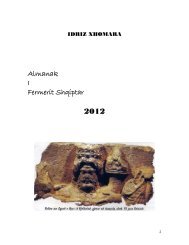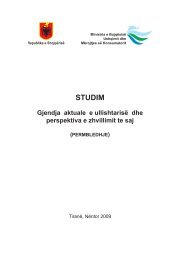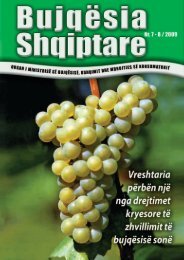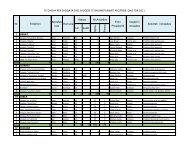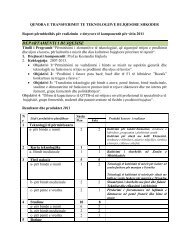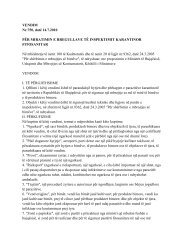MEAT Sector Analyse
MEAT Sector Analyse
MEAT Sector Analyse
- TAGS
- sector
- analyse
- mbumk.gov.al
Create successful ePaper yourself
Turn your PDF publications into a flip-book with our unique Google optimized e-Paper software.
II. Producers/Farmers<br />
Cattle<br />
Meat <strong>Sector</strong> Study<br />
According to MAFCP there are 297,418 farms keeping animals and out of them 226,442<br />
farms keep cattle. The total number of cattle is decreasing over the last years; from 634,000<br />
in 2006, to 577,000 in 2007 and finally to 494,000 in 2009; number of cows is 353,000.<br />
Major regions with cattle farms are Fier, Elbasan, Tirana and Shkoder.<br />
On Albanian farms the following – mainly milk oriented - breeds can be encountered; Jersey<br />
(35 %), Laramane e zeze (Black & White) (29 %), domestic breeds like (15 %), Holstein (13<br />
%) and Simmental (3 %) and others like Taranteze. (Source: MAFCP, 2008, Technical<br />
Report)<br />
The way the cattle are kept on the farms is quite different; on one side there are many small<br />
subsistence farms with 1 – 2 cows, mainly for milking. Albanian average herd size is 2.4<br />
cattle. Animals are staying in primitive tied stall barns, often without any windows. All the<br />
work is done by hand; feeding, removing the manure and also milking.<br />
On the other side there are specialised farms, many more on milk than on meat, with better<br />
premises, even of the majority uses old existing buildings which are slightly adapted.<br />
Nevertheless electricity is often missing, windows very limited so that it is quite dark in the<br />
stables and just a handful of farms has a dung removal installation – partly because labour is<br />
so cheap. Again with very few exceptions there are no manure handling, storage and<br />
treatment facilities.<br />
The number of farms having more than 5 heads is 2,904 and equivalents to around 1 % of all<br />
cattle farms. 20 farms in Albania have more than 50 heads; Lushnja is one farm with 200<br />
calves for fattening.<br />
Slaughtering of cattle is done partly on the farm by the farmer or the butcher who then takes<br />
the meat to his shop. Or the butcher does the slaughtering behind his shop as clients want to<br />
see live animals and are sceptical about readymade de-boned. The correct way foresees<br />
that cattle are slaughtered in approved slaughterhouses; but given the small number of<br />
slaughterhouses – around 20 – in operation and the fact that many of them process just 2<br />
cows a day, one may conclude that slaughtering is not properly done according to the law.<br />
The liquid and solid waste from slaughtering on the farm or in small slaughter points is<br />
bought into illegal landfills and taken away by nearby rivers.<br />
As most farmers are not specialised in meat production they slaughter their animals, calves,<br />
too young and before gaining sufficient weight. The average live weight of slaughtered calves<br />
is about 180 – 200 kg (150 - 170 kg), which is economically much too low; sometimes male<br />
veal is slaughtered with 3 - 4 months and a live weight of 100 kg! Reasons for to early<br />
slaughtering are the demand for very young animals (of all kinds) and the unavailability of<br />
cheap fodder.<br />
Interesting to note that the demand is not expressed in higher prices for younger animals;<br />
experts from the Agriculture Know-How Transfer Centre in Fushe Kruje mentioned that the<br />
sales price for 1 kg live weight is around Lek 300 regardless if the animals has 200 or 400 kg.<br />
To stop the trend slaughtering young animals the MAAR started recently an awareness<br />
campaign promoting 12 months old calves with 400 kg live weight as the ideal weight for<br />
slaughtering.<br />
Meat <strong>Sector</strong> Study, page 14



